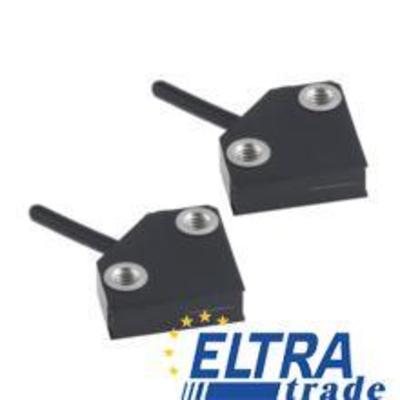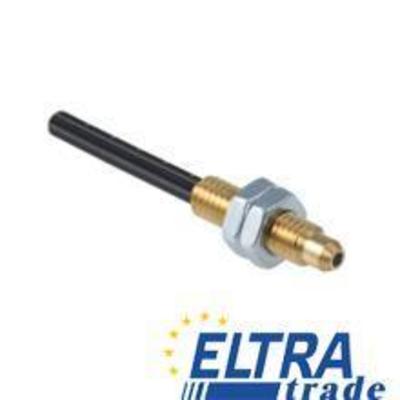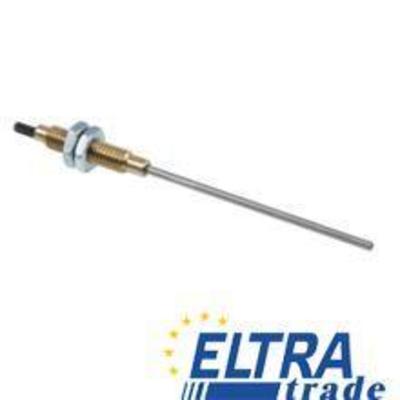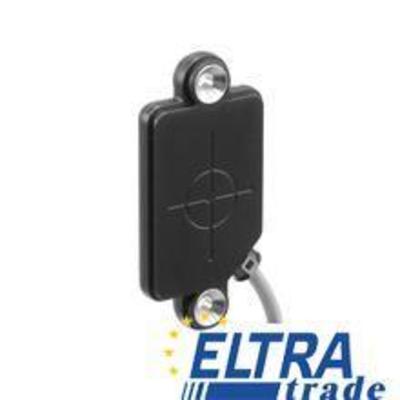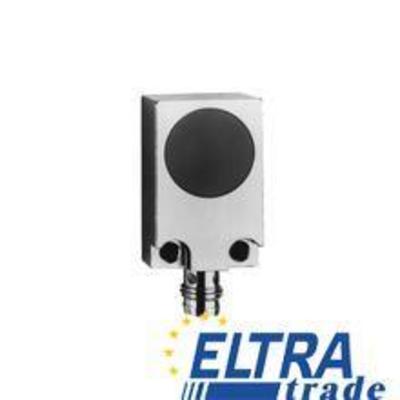Baumer Sensors
| sensing distance Tw | 25 mm |
| sensor channels | 4 (teachable) |
| tolerance ranges | 5-step teachable (LEDs) |
| operating temperature | -10 ... +55 °C |
art. 10133599
| type | diffuse contrast sensor |
| light source | pulsed red laser diode |
| sensing distance Tw | 0 ... 250 mm |
| operating temperature | -10 ... +50 °C |
art. 10148822
- UNAM 18I6903/S14 withcurrent output
- 100 ... 1000 mm
- -10 ... +60 °C
art. 10157539
| scanning range sd | 40 ... 400 mm |
| scanning range far limit Sde | 60 ... 400 mm |
| hysteresis typ. | 4 % Sde |
| output circuit | NPN make function (NO) |
| operating temperature | -10 ... +60 °C |
art. 10232784
| scanning range sd | 100 ... 1000 mm |
| scanning range far limit Sde | 100 ... 1000 mm |
| hysteresis typ. | 4 % Sde |
| output circuit | PNP break function (NC) |
| operating temperature | -10 ... +60 °C |
art. 10135305
| particular characteristics | coaxial |
| type | Diffuse sensors |
| sensing distance Tw | 1 ... 60 mm |
| operating temperature | -30 ... +70 °C |
art. 10135350
| particular characteristics | parallel beam |
| type | through beam sensor |
| actual range Sb | 4140 mm |
| operating temperature | -30 ... +70 °C |
art. 10151375
| particular characteristics | array (fine light barrier) |
| type | through beam sensor |
| actual range Sb | 780 mm |
| operating temperature | -30 ... +70 °C |
art. 10240061
| particular characteristics | standard |
| type | Diffuse sensors |
| sensing distance Tw | 1 ... 300 mm |
| operating temperature | -30 ... +70 °C |
art. 10124815
| particular characteristics | small sensing head sensing head can be bent once |
| type | Diffuse sensors |
| sensing distance Tw | 1 ... 120 mm |
| operating temperature | -30 ... +70 °C |
art. 10125522
Ultrasonic distance sensors
- Wide measuring range
- High measurement accuracy
- Wide range of operating temperatures
- Resistance to dirt and vibrations
art. 10131958
Ultrasonic sensors UZDK 30N6112/S14
- Extended working distance
- Extended temperature range
- Extended operating voltage range
- Functional safety
- Robust construction
art. 11232878
- M12, female, A-coded, 4-poles; PUR, 100 cm, free cable end
- Dragchain capable; suitable for robotics ± 180 °/m
- Head A: IP65, IP66K, IP67
- Cable: good resistance against chemicals, flames, oils
art. 11232883
- M12, female, A-coded, 4-poles; PUR, 100 cm, shielded, free cable end
- Dragchain capable
- Head A: IP65, IP66K, IP67
- Cable: good resistance against chemicals, flames, oils
art. 11230352
- Encoder with blind or through hollow shaft ø12 mm
- Optical sensing method
- Max. 5000 pulses per revolution
art.11233075
- M12, male, D-coded, 4-poles; PUR, 100 cm, shielded, free cable end
- Dragchain capable
- Head A: IP67
- Cable: good resistance against flames, oils
- Halogen free
art. 11230367
- M12, male, X-coded, 8-poles; PUR, 500 cm, shielded; RJ45, male, X-coded, 8-poles
- Dragchain capable; suitable for robotics ± 180 °/m, CAT6A, 10GBit/s
- Head A: IP66K, IP67; Head B: IP20
- Cable: good resistance against flames, oils
art. 11045948
| special type | liquid level sensor for wastewater |
| nominal sensing distance Sn | 0,1 mm |
| mounting type | non-flush |
| output circuit | NPN break function (NC) |
| operating temperature | 0 ... +50 °C |
art. 10119679
| nominal sensing distance Sn | 4 mm |
| nominal sensing distance Sn adjustable | 0,5 ... 4 mm |
| mounting type | flush |
| output circuit | NPN make function (NO) |
| operating temperature | -25 ... +75 °C |
art. 10119694
| nominal sensing distance Sn | 8 mm |
| nominal sensing distance Sn adjustable | 2 ... 8 mm |
| mounting type | flush |
| output circuit | PNP break function (NC) |
| operating temperature | -25 ... +75 °C |
art. 10119711
| nominal sensing distance Sn | 15 mm |
| nominal sensing distance Sn adjustable | 4 ... 15 mm |
| mounting type | flush |
| output circuit | NPN make function (NO) |
| operating temperature | -25 ... +75 °C |
art. 11076813
| nominal sensing distance Sn | 8 mm |
| mounting type | flush |
| GND electrode | no |
| operating temperature | -25 ... +75 °C |
art. 11050685
| nominal sensing distance Sn | 12 mm |
| mounting type | flush |
| GND electrode | no |
| operating temperature | -25 ... +75 °C |
art. 10119714
| nominal sensing distance Sn | 15 mm |
| nominal sensing distance Sn adjustable | 4 ... 15 mm |
| mounting type | flush |
| output circuit | NPN make function (NO) |
| operating temperature | -25 ... +75 °C |
art. 10119712
| nominal sensing distance Sn | 15 mm |
| nominal sensing distance Sn adjustable | 4 ... 15 mm |
| mounting type | flush |
| output circuit | PNP break function (NC) |
| operating temperature | -25 ... +75 °C |
art. 10112672
| nominal sensing distance Sn | 5 mm |
| mounting type | flush |
| GND electrode | yes |
| output circuit | PNP make function (NO) |
| operating temperature | -25 ... +75 °C |
art. 10119700
| nominal sensing distance Sn | 5 mm |
| mounting type | flush |
| GND electrode | yes |
| output circuit | PNP break function (NC) |
| operating temperature | -25 ... +75 °C |
Sensor Baumer ch 8501
- Type of output signal:
- PNP: contact closure (NO)
- NPN: NC contact (NC)
- Switching frequency: Up to 1 kHz
- Housing material: ABS plastic
CTX Baumer - Pressure sensor for general air and gas applications
- Relative pressure measurement from -1 to 200 bar
- Robust ceramic measuring cell
- Stainless steel housing
FADK 14I4470/S14/IO art. 11014496
| measuring distance Sd | 50 ... 400 mm |
| adjustment | IO-Link |
| Teach-in range min. | > 20 mm |
| operating temperature | 0 ... +50 °C |
 Baumer sensors have been leading the market for many years and are widely used for automated process control systems in different areas of the heavy and light industry. It is worth noting that during the years of its work Baumer company has presented a huge nomenclature of such controllers and all sorts of auxiliary elements to them that meet the latest achievements in the field of sensor technologies.
Baumer sensors have been leading the market for many years and are widely used for automated process control systems in different areas of the heavy and light industry. It is worth noting that during the years of its work Baumer company has presented a huge nomenclature of such controllers and all sorts of auxiliary elements to them that meet the latest achievements in the field of sensor technologies.
Working on the development of a new modification of the controller, Baumer developers took into account the fact that for each of the above-mentioned directions in the industry sensors with specific needs are required. That is why, today, a range of sensor lines is available that can 100% meet the stringent requirements of any production process.
- Inductive, Baumer photoelectric sensors, supersonic, capacitive, and magnetic devices can provide the highest degree of safety to any object, so they are widely used in alarm and security systems.
- Modifications of controllers without bearings and cables help to remotely control the mileage, route, and speed of any vehicle equipment.
- Absolute and incremental encoders are designed for heavy-duty applications and are widely used in a variety of heavy industrial applications.
- Strain gauges, level gauges, and temperature sensors will ensure proper control of the relevant characteristics in all stages of the process.
In addition, a huge range of sensors from leading Baumer sensors distributors is available on the market today, providing reliable operation of image processing and recognition systems, industrial cameras as well as special system components.
Sensors can also be divided into several categories, depending on the force applied to them:
- Force - they respond to a force impact, such as a shock or touch, to vibration. The simplest example of using such sensors could be a smartphone or tablet.
- Temperature sensors react to temperature rise or fire. They are indispensable sensors when creating fire safety systems at home or industrial premises.
- Hydrometeorological - are triggered by various weather indicators, namely water or snow, wind speed, atmospheric pressure, and many others.
- Spatial - react to the movement of the sensor in space, for example, when you change the angle of inclination (gyroscope) when moving, etc.
Baumer Sensor Solutions varieties:
- Position sensors - non-contact limit switches with a configurable trigger range;
- Distance and motion sensors - non-contact transducers of motion into an analog or digital signal.
Device Types:
- Analog output and adjustable control limits. A potentiometer slot is provided on the housing for this purpose.
- Analog output and memory for the detection range. The minimum and maximum limits are set and stored in an energy-dependent memory during self-learning of the device. To control the range, the object is left in front of the device at the first distance boundary, the programming button is pressed, and then the object is moved to the next boundary and the button is reactivated.
- Devices with such a device are designed to convert the linear value of the distance to the controlled object into the electrical value of 4...20 mA or 0...10 Volt, or inverse 20...4 mA or 10...0 Volt. Measures at least half an mm at distances up to one meter and one mm beyond one meter.
Sensors with 2 digital outputs and boundary memory are also available. Threshold control, where fluid level and sag size can be no greater than one, but no smaller than the other value. The actuator connects to one gauge rather than two. This device is used in applications where the liquid in the tank is controlled by two characteristics, with two auxiliary levels.
Baumer sensor catalogue
Baumer sensors USA are measuring instruments designed to generate a signal of measured data in a form suitable for further conversion, storage, or processing. Devices based on electronic parts are called electronic sensors.
A sensor consists of transducer and sensing elements. The main parameters of the devices are error and sensitivity. Devices are widely used in quality control, automated control systems, industry, manufacturing plants, automotive industry. Everywhere where there is a need to obtain measurement information.
Main types of presence and distance sensors:
- Optical sensors- photoelectric, laser.
- Ultrasonic.
- Inductive.
- Magnetic.
- Capacitive.
- Mechanical.
Baumer Industrial sensors
Baumer sensors are made in strict accordance with the requirements of international quality standards and allow their application in industrial processes, both in aggressive environments and in environments critical to the influence of foreign substances on the process or the quality of the final product. For this reason, various modifications of sensor sensors are actively used today for process automation in the following industries:
- mechanical engineering;
- drive engineering;
- renewable energy (wind and solar);
- security and alarm systems;
- logistics and transport (rail or heavy transport, cranes);
- oil and gas industry;
- full automation of various industries.
It is worth noting that for each of the above-mentioned areas of application Baumer has developed certain sensors that can fully meet all the needs of the consumer. Sensors of this manufacturer have found wide application in different spheres of industry, so among the range of products, there are incremental and absolute models, as well as modifications of devices designed for heavy-duty modes of operation.
Also, the manufacturer will delight you with special temperature sensors, level gauges, and strain gauges that provide reliable control of the specified characteristics for all processes. Special system components, industrial cameras, and starting packages for image recognition and processing, whose qualitative and reliable operation is based on Baumer touch sensors, are especially popular today.
For example, in security and alarm systems magnetic, capacitive, supersonic, photoelectric, and inductive sensors are used, capable of providing maximum security to any object. To measure the distance and control the movement of vehicles presented special devices without cables and bearings. With these devices, you can remotely control the route, speed, and kilometrage of motor vehicles.
Baumer ultrasonic sensors
The working principle of Baumer ultrasonic sensors is that the equipment operates on the basis of the piezo effect, in which the quartz or ceramic plate changes its geometric parameters, and on the surface, an electric field is formed by an external mechanical influence.
The plate vibrates with the frequency of the electric field, which leads to the propagation of waves of similar frequency. They travel through the air and are reflected by objects, returning back to the source. When the plate is exposed, an electric field is generated. The plate initially radiates the waves and then receives them. You can control the response spectrum of the sensor by adjusting the wavelength.
Devices with such a device are designed to convert the linear value of the distance to the controlled object into an electrical value of 4...20 mA or 0...10 Volt, or inverse 20...4 mA or 10...0 Volt. Measurement of at least half an mm at a distance of up to one meter and one mm at a distance beyond one meter.
More detailed information you can find here:







